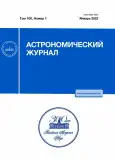Laboratory Simulation of Photosynthesis in a Wide Range of Electromagnetic and Radiation Environment Parameters
- 作者: Grinberg M.A.1,2, Vodeneev V.A.1,2, Il’in N.V.1,2, Mareev E.A.1,2
-
隶属关系:
- Lobachevsky State University
- Institute of Applied Physics, Russian Academy of Sciences
- 期: 卷 100, 编号 1 (2023)
- 页面: 81-88
- 栏目: Articles
- URL: https://journals.rcsi.science/0004-6299/article/view/139056
- DOI: https://doi.org/10.31857/S0004629923010024
- EDN: https://elibrary.ru/NPNBXC
- ID: 139056
如何引用文章
全文:
详细
The problem of studying the limits of stability and mechanisms of adaptation of living systems to environmental parameters that vary over a wide range is briefly analyzed. The main attention is focused on the analysis of the electromagnetic environment and background radiation. These factors vary relatively little on the modern Earth, which leads to their insufficient knowledge. At the same time, they present serious challenges for future space missions. One of the main methods for studying the influence of such factors on living organisms is laboratory simulation. Previous experiments have demonstrated the need to develop a new laboratory setup, the requirements for the parameters of which are presented in this paper. In general, the setup will have a high potential for solving the problems of modeling the effect of astro-geophysical factors on the physiological state of living organisms and, in particular, the activity of photosynthesis in higher plants. The implementation of the proposed program of laboratory simulation experiments will allow us to advance in understanding the problems of life evolution, the mechanisms of the possible influence of solar activity on the biosphere, and studies of the role of the biosphere in global climate changes of planets at various time horizons.
作者简介
M. Grinberg
Lobachevsky State University; Institute of Applied Physics, Russian Academy of Sciences
Email: mareev@ipfran.ru
Nizhny Novgorod, Russia; Nizhny Novgorod, Russia
V. Vodeneev
Lobachevsky State University; Institute of Applied Physics, Russian Academy of Sciences
Email: mareev@ipfran.ru
Nizhny Novgorod, Russia; Nizhny Novgorod, Russia
N. Il’in
Lobachevsky State University; Institute of Applied Physics, Russian Academy of Sciences
Email: mareev@ipfran.ru
Nizhny Novgorod, Russia; Nizhny Novgorod, Russia
E. Mareev
Lobachevsky State University; Institute of Applied Physics, Russian Academy of Sciences
编辑信件的主要联系方式.
Email: mareev@ipfran.ru
Nizhny Novgorod, Russia; Nizhny Novgorod, Russia
参考
- G. Elhalel, C. Price, D. Fixier, A. Shainberg, Nature. Scientific Reports 9, 1645 (2019).
- C. Doglioni, J. Pignatti, M. Coleman, Geosc. Front. 7, 865–873 (2016).
- Y. Berkovich, I. Konovalova, S. O. Smolyanina, A. N. Erokhin, O. V. Avercheva, E. M. Bassarskaya, G. V. Kochetova, T. V. Zhigalova, O. S. Yakovleva, I. G. Tarakanov, REACH 6, 11–24 (2017).
- E. N. Baranova, M. A. Levinskikh, A. A. Gulevich, Life 9, 81 (2019).
- V. De Micco, C. Arena, D. Pignalosa, M. Durante, Radiat. Environ. Biophys. 50, 1–19 (2011).
- M. E. Maffei, Front. Plant Sci. 5, 445 (2014).
- S. V. Gudkov, M. A. Grinberg, V. S. Sukhov, V. A. Vodeneev, J. Environ Radioact. 202, 8–24 (2019).
- M. Sarraf, S. Kataria, H. Taimourya, L. O. Santos, R. D. Menegatti, M. Jain, M. Ihtisham, S. Liu, Plants 9, 1139 (2020).
- A. De Souza-Torres, L. Sueiro-Pelegrín, M. Zambrano-Reyes, I. Macías-Socarras, M. González-Posada, D. Gar-cía-Fernández, Int. J. Rad. Biol. 96, 951–957 (2020).
- P. Y. Volkova, E. V. Bondarenko, E. Kazakova, Curr. Opin. Toxicol. 30, 100334 (2022).
- V. N. Binhi, A. B. Rubin, Cells 11, 274 (2022).
- I. Kovalchuk, J. Molinier, Y. Yao, A. Arkhipov, O. Kovalchuk, Mutat. Res. 624, 101–113 (2007).
- E. J. Goh, J. B. Kim, W. J. Kim, B. K. Ha, S. H. Kim, S. Y. Kang, Y. W. Seo, D. S. Kim, Radiat. Environ. Biophys. 53, 677–693 (2014).
- M. V. Kryvokhyzha, K. V. Krutovsky, N. M. Rashydov, Int. J. Rad. Biol. 95, 626–634 (2019).
- M. Grinberg, S. V. Gudkov, I. V. Balalaeva, E. Gromova, Y. V. Sinitsyna, V. S. Sukhov, V. A. Vodeneev, Environ. Exp. Bot. 184, 104378 (2021).
- V. Sukhov, E. Sukhova, Y. Sinitsyna, E. Gromova, N. Mshenskaya, A. Ryabkova, N. Ilin, V. Vodeneev, E. Mareev, C. Price. Cells. 10, 149 (2021).
- E. Sukhova, E. Gromova, L. Yudina, A. Kior, Y. Vetrova, N. Ilin, E. Mareev, V. Vodeneev, V. Sukhov, Plants 10, 2207 (2021).
- M. Grinberg, M. Mudrilov, E. Kozlova, V. Sukhov, F. Sa-rafanov, A. Evtushenko, N. Ilin, V. Vodeneev, C. Price, E. Mareev, Plant Signal. Behav. 17, 2021664 (2022).
- J. L. Araus, S. C. Kefauver, O. Vergara-Díaz, A. Gracia-Romero, F. Z. Rezzouk, J. Segarra, M. L. Buchaillot, M. Chang-Espino, T. Vatter, R. Sanchez-Bragado, J. A. Fernandez-Gallego, M. D. Serret, J. Bort, J. Integr. Plant. Biol. 64, 592–618 (2022).
- D. Sun, K. Robbins, N. Morales, Q. Shu, H. Cen, Trends Plant. Sci. 27, 191–208 (2022).
- F. Tanner, S. Tonn, J. de Wit, G. Van den Ackerveken, B. Berger, D. Plett, Plant Methods 18, 35 (2022).
- K. Maxwell, G. N. Johnson, J. Exp. Bot. 51, 659–68 (2000).
- A. E. Huber, T. L. Bauerle, J. Exp. Bot. 67, 2063–2079 (2016).
- S. K. Chatterjee, O. Malik, S. Gupta, Biosensors (Basel) 8, 83 (2018).
补充文件













